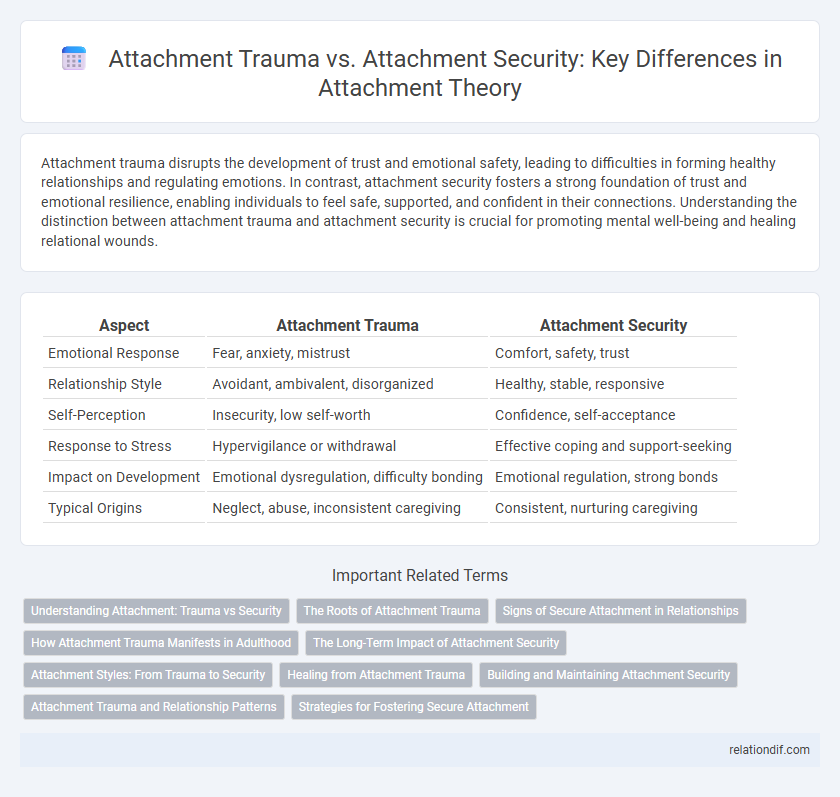Attachment trauma disrupts the development of trust and emotional safety, leading to difficulties in forming healthy relationships and regulating emotions. In contrast, attachment security fosters a strong foundation of trust and emotional resilience, enabling individuals to feel safe, supported, and confident in their connections. Understanding the distinction between attachment trauma and attachment security is crucial for promoting mental well-being and healing relational wounds.
Table of Comparison
| Aspect | Attachment Trauma | Attachment Security |
|---|---|---|
| Emotional Response | Fear, anxiety, mistrust | Comfort, safety, trust |
| Relationship Style | Avoidant, ambivalent, disorganized | Healthy, stable, responsive |
| Self-Perception | Insecurity, low self-worth | Confidence, self-acceptance |
| Response to Stress | Hypervigilance or withdrawal | Effective coping and support-seeking |
| Impact on Development | Emotional dysregulation, difficulty bonding | Emotional regulation, strong bonds |
| Typical Origins | Neglect, abuse, inconsistent caregiving | Consistent, nurturing caregiving |
Understanding Attachment: Trauma vs Security
Attachment trauma results from inconsistent or harmful caregiving, leading to difficulties in forming trust and emotional regulation, while attachment security develops through reliable and responsive care, fostering stable relationships and emotional resilience. Understanding the key differences between attachment trauma and attachment security highlights the impact of early caregiver interactions on brain development and stress responses. This distinction is critical for therapeutic approaches addressing emotional healing and promoting secure attachment patterns in both children and adults.
The Roots of Attachment Trauma
Attachment trauma originates from early relational disruptions where caregivers are inconsistent, neglectful, or abusive, hindering the formation of secure emotional bonds. This trauma disrupts the development of attachment security, leading to difficulties in trust, emotional regulation, and interpersonal relationships throughout life. Neuroscientific studies reveal that attachment trauma affects brain areas responsible for stress responses and emotional processing, reinforcing maladaptive attachment patterns.
Signs of Secure Attachment in Relationships
Signs of secure attachment in relationships include consistent emotional availability, trust, and effective communication between partners. Individuals with secure attachment tend to express their needs openly, respond empathetically to their partner's feelings, and maintain a healthy balance of independence and intimacy. These behaviors foster stability, mutual support, and resilience in the relationship, contrasting sharply with the instability and anxiety found in attachment trauma.
How Attachment Trauma Manifests in Adulthood
Attachment trauma in adulthood often manifests through emotional dysregulation, difficulty in forming or maintaining healthy relationships, and pervasive feelings of insecurity or fear of abandonment. Individuals with attachment trauma may exhibit avoidant or anxious behaviors, struggle with trust, and experience heightened sensitivity to rejection or criticism. In contrast, attachment security fosters emotional resilience, stable interpersonal connections, and a balanced approach to intimacy and independence.
The Long-Term Impact of Attachment Security
Attachment security fosters emotional resilience and healthy interpersonal relationships over time, while attachment trauma can lead to chronic difficulties in trust, self-regulation, and mental health. Neurobiological studies reveal that secure attachment positively influences brain development, promoting effective stress response and emotional regulation mechanisms. Long-term secure attachment serves as a protective factor against anxiety, depression, and relational conflict throughout adulthood.
Attachment Styles: From Trauma to Security
Attachment trauma disrupts the development of secure attachment styles, often resulting in patterns of anxiety, avoidance, or disorganization in relationships. Secure attachment emerges through consistent, responsive caregiving that fosters emotional regulation and trust, promoting healthy interpersonal connections. Therapeutic interventions targeting attachment styles can help individuals transition from trauma-induced insecurity to secure relational patterns.
Healing from Attachment Trauma
Healing from attachment trauma involves rebuilding trust and emotional safety through consistent, supportive relationships that foster attachment security. Therapeutic approaches such as trauma-informed therapy and somatic experiencing help individuals process and integrate painful attachment experiences, promoting emotional regulation and resilience. Strengthening secure attachment bonds enhances self-worth and reduces the impact of early relational wounds on mental health.
Building and Maintaining Attachment Security
Building and maintaining attachment security involves consistent, responsive caregiving that fosters trust and emotional safety, essential for healthy brain development and emotional regulation. Attachment security promotes resilience by enabling individuals to form stable relationships and effectively manage stress, contrasting sharply with attachment trauma, which disrupts these processes and leads to difficulties in emotional bonding and self-regulation. Therapeutic interventions and secure relational experiences are critical to repairing attachment trauma and reinforcing attachment security throughout life stages.
Attachment Trauma and Relationship Patterns
Attachment trauma disrupts secure attachment by creating deep emotional wounds that influence relationship patterns, often resulting in mistrust, avoidance, or anxious behaviors. Individuals with attachment trauma may exhibit difficulties forming healthy bonds, experiencing heightened fear of abandonment or intimacy. These maladaptive relationship patterns perpetuate cycles of insecurity and emotional dysregulation, impairing the capacity for stable, supportive connections.
Strategies for Fostering Secure Attachment
Fostering secure attachment involves consistent emotional responsiveness and creating a safe environment where trust can develop. Caregivers should practice sensitive attunement by recognizing and appropriately responding to a child's emotional needs, which helps mitigate attachment trauma. Building predictable routines and offering empathetic communication strengthen the child's sense of security and promote healthy relational patterns.
Attachment Trauma vs Attachment Security Infographic

 relationdif.com
relationdif.com